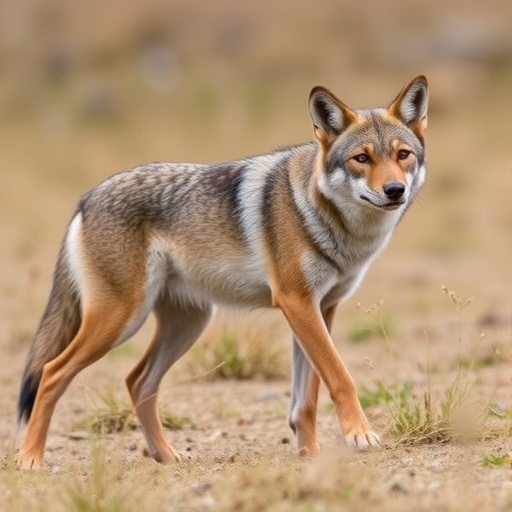In recent years, the challenges of managing wildlife populations have come to the forefront, particularly with species that exhibit unique reproductive characteristics like the Eastern coyote. A compelling study conducted by researchers at the University of Georgia sheds light on the complexities of controlling coyote populations in the southeastern United States. The findings reveal that efforts to manage coyote numbers may be futile due to their remarkable adaptability and reproductive capabilities. This unprecedented ability to recover quickly, often faster than control measures can act, presents a significant challenge for wildlife management strategies.
In the analysis, researchers meticulously evaluated coyote populations across various terrains within the Southeast, specifically focusing on the Savannah River Site in South Carolina. Utilizing advanced methodologies, including motion-sensing cameras and acoustic monitoring of coyote vocalizations, the team was able to determine coyote densities to provide a clearer understanding of their distribution within regional ecosystems. The results were astonishing; researchers discovered populations ranging from 45 to 50 coyotes for every 38-square-mile area surveyed, translating to more than one coyote per square mile. This revelation indicates that coyotes may be more prevalent in wooded or forested areas than previously assumed, contradicting earlier assumptions that these animals prefer open habitats.
The profound ability of coyotes to adapt to diverse habitats has significant implications for wildlife management. Various factors contribute to their current success, including reduced competition from other apex predators and an abundance of prey species. Remarkably, for over 75 years, the Southeast has experienced a decline in apex predator populations, allowing coyotes to fill ecological voids and capitalize on naive prey. The unique dynamics of ecological relationships in the region underscore the complexities wildlife managers must navigate when developing population control strategies.
Repeated attempts to reduce coyote numbers through removal or control measures have proven largely ineffective. The study revealed that despite multiple culling efforts over the course of the last 18 years, coyote populations consistently rebounded and sometimes even thrived in the aftermath of such interventions. This rebound can be attributed not only to the coyotes’ high reproductive rates but also to the influx of coyotes migrating from adjacent regions in search of territory. This phenomenon makes the already challenging task of wildlife management even more daunting.
Researchers projected that current population control measures are both cost-prohibitive and unsustainable in the long run. With operational costs ranging between $30,000 to $50,000, the financial implications of coyote removal efforts are substantial. Not only do these economic burdens strain wildlife management budgets, but they also divert resources from potentially more impactful, long-term solutions. By recognizing the limitations of traditional methods, researchers advocate for a shift in focus towards more sustainable management practices that promote coexistence rather than eradication.
An alternative approach could involve revising hunting regulations or enhancing habitats to bolster populations of non-coyote species that offer ecological balance within the ecosystem. Such measures could promote biodiversity while acknowledging the ongoing presence of coyotes in the area. Furthermore, habitat enhancement could support a wider array of wildlife, providing a more intricate and resilient ecosystem. Ultimately, acknowledging that traditional predator control measures may yield limited benefits could lead to a paradigm shift towards innovative ecological strategies that proactively foster healthy wildlife populations.
The implications of this research extend beyond mere population numbers; they affect entire ecosystems and the management practices employed by wildlife officials. As environmental conditions and human-induced changes continue to impact landscapes, wildlife biologists are challenged to adapt management protocols to ensure ecological health. This complex interplay between species dynamics and habitat management emphasizes the need for collaborative, interdisciplinary approaches to wildlife conservation.
Moreover, a thorough understanding of the ecological roles of Coyotes is crucial. They can exert significant influence on prey dynamics and, by extension, on plant communities, leading to various cascading effects throughout the ecosystem. As coyotes occupy various ecological niches, it becomes essential to investigate their impact on other species and how this dynamic interplay shapes regional biodiversity.
In conclusion, the study conducted by the University of Georgia represents a pivotal moment in understanding the intricacies of coyote management. Rather than relying on outdated methods that have proven unsuccessful, wildlife officials and conservationists must embrace adaptable and innovative strategies that correspond with the realities of coyote behavior and ecology. The findings illustrate the pressing need to reconsider traditional management approaches and underscore the importance of fostering resilient ecosystems that can thrive alongside adaptive wildlife like the Eastern coyote.
In light of these insights, it becomes imperative for scientists, policymakers, and the public to engage in nuanced discussions about the realities of wildlife management in the contemporary era. As coyote populations continue to adapt and thrive in unprecedented ways, a collective effort is necessary to ensure the longevity and ecological integrity of the regions they inhabit.
Subject of Research: Coyote Population Dynamics in Southeast USA
Article Title: An integrated population model of a high-density coyote population in South Carolina, USA
News Publication Date: 12-Jul-2025
Web References: Ecosphere Journal
References: N/A
Image Credits: N/A
Keywords
Coyote Management, Wildlife Ecology, Population Control, Habitat Management, Biodiversity, Southeast USA, Apex Predators, Ecological Dynamics, Conservation Strategies.




